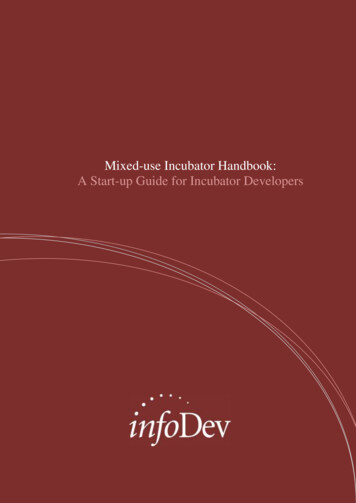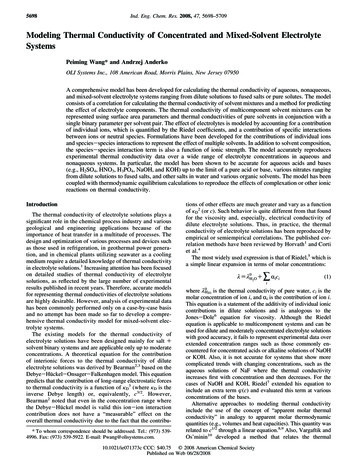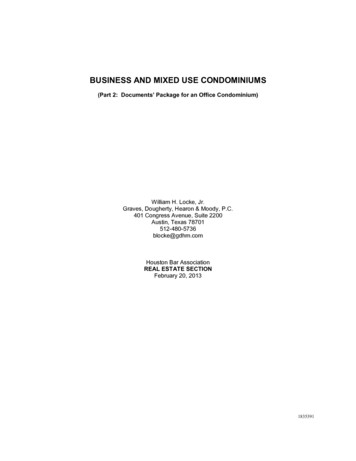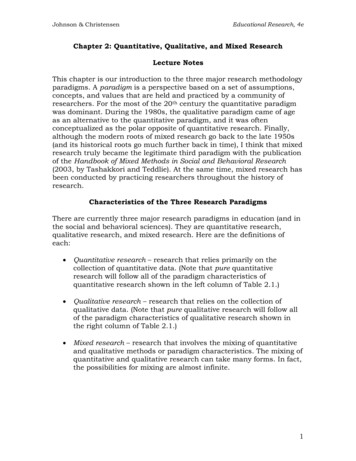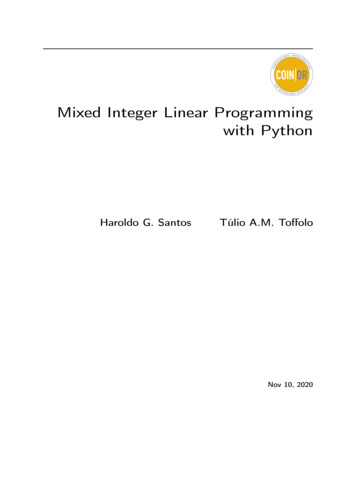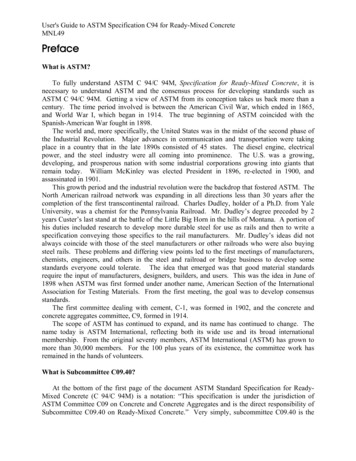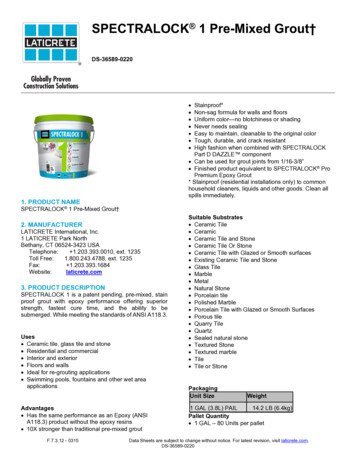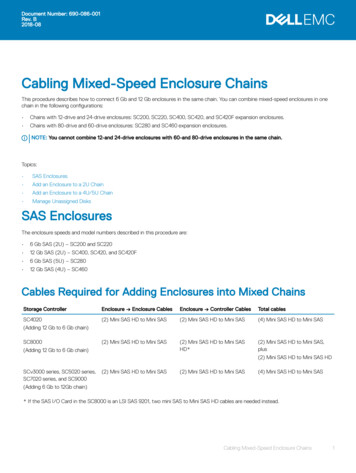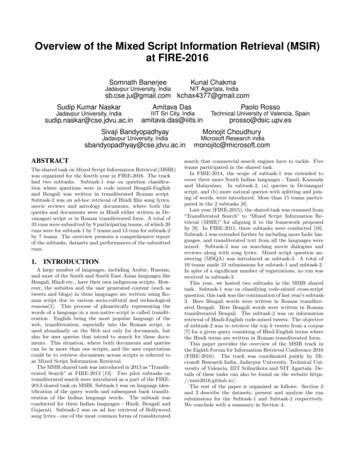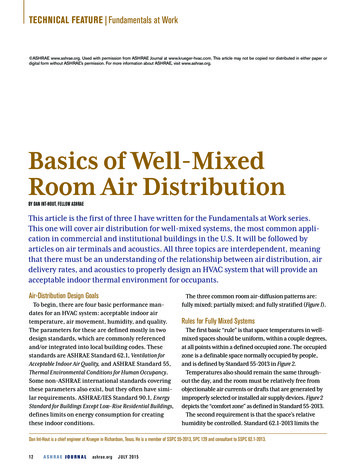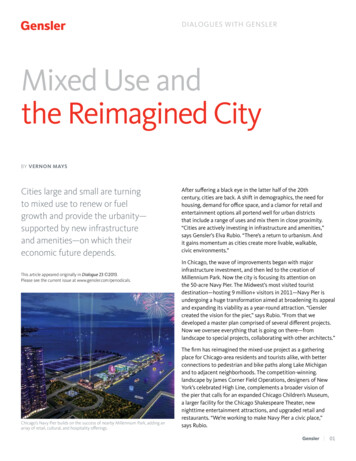
Transcription
DIALOGUES WITH GENSLERMixed Use andthe Reimagined CityBY VERNON MAYSCities large and small are turningto mixed use to renew or fuelgrowth and provide the urbanity—supported by new infrastructureand amenities—on which theireconomic future depends.This article appeared originally in Dialogue 23 2013.Please see the current issue at www.gensler.com/periodicals.Chicago’s Navy Pier builds on the success of nearby Millennium Park, adding anarray of retail, cultural, and hospitality offerings.After suffering a black eye in the latter half of the 20thcentury, cities are back. A shift in demographics, the need forhousing, demand for office space, and a clamor for retail andentertainment options all portend well for urban districtsthat include a range of uses and mix them in close proximity.“Cities are actively investing in infrastructure and amenities,”says Gensler’s Elva Rubio. “There’s a return to urbanism. Andit gains momentum as cities create more livable, walkable,civic environments.”In Chicago, the wave of improvements began with majorinfrastructure investment, and then led to the creation ofMillennium Park. Now the city is focusing its attention onthe 50-acre Navy Pier. The Midwest’s most visited touristdestination—hosting 9 million visitors in 2011—Navy Pier isundergoing a huge transformation aimed at broadening its appealand expanding its viability as a year-round attraction. “Genslercreated the vision for the pier,” says Rubio. “From that wedeveloped a master plan comprised of several different projects.Now we oversee everything that is going on there—fromlandscape to special projects, collaborating with other architects.”The firm has reimagined the mixed-use project as a gatheringplace for Chicago-area residents and tourists alike, with betterconnections to pedestrian and bike paths along Lake Michiganand to adjacent neighborhoods. The competition-winning.landscape by James Corner Field Operations, designers of NewYork’s celebrated High Line, complements a broader vision ofthe pier that calls for an expanded Chicago Children’s Museum,a larger facility for the Chicago Shakespeare Theater, newnighttime entertainment attractions, and upgraded retail andrestaurants. “We’re working to make Navy Pier a civic place,”says Rubio. 01
DIALOGUES WITH GENSLERFIGat7th in Los AngelesDriven by RetailWhile Chicago’s lakefront and its entertainment potentialare strong attractions, other cities are banking on the rise ofwalkable urbanism to spark new mixed-use developments.Take OliverMcMillan’s River Oaks District, a retail-focuseddevelopment now under way in Houston. Covering six cityblocks in an affluent neighborhood, it will add new housing,office space, and 270,000 square feet of luxury and boutiqueretail lining shade-covered streets. “It’s about creating a citystreet–like pedestrian district that’s activated 24/7 by themix, including new offices and some 300 new residences,”Gensler’s Duncan Paterson explains.River Oaks has been significantly recalibrated for a changingmarket, notes Gensler’s Marty Borko. “OliverMcMillan took itfrom a highrise to a ‘city neighborhood’ pattern, with retail atthe base and office and residential above.” For Houston, someretail and restaurant tenants want two-story spaces, often withdramatic interiors and roof terraces, while others are looking formore intimate spaces, some as small as 600 square feet. “Whenyou put them together,” Borko says, “it gives River Oaks a muchmore interesting streetscape.”Sparking RenewalUS cities large and small are embracing mixed use as a catalystfor revitalization. In Hartford, Connecticut, for example, Gensleris working with a developer team on a proposed mixed-usedistrict in the area between the XL Center arena and Hartford’shistoric railroad station. Transit is a key component driving thedowntown project, whose goal is to remove outdated buildingsand stimulate a wide variety of activity within the “walkshed” ofa recast Union Station, envisioned as a hub for commuter rail andbus service. Likewise, in Indianapolis, the city believed so stronglyin the future of the 14-acre CityWay development that it financeda construction loan to push the project ahead. DeveloperBuckingham Companies’ new urban neighborhood combinesrestaurants, offices, upscale residences, and The Alexander, aGensler-designed, 209-room hotel that makes fine art a feature.Department stores can be found in many US cities’ downtowns,notes Gensler’s Kathleen Jordan. They stand to benefit fromwalkable urbanism—and are doing so in some markets.Elsewhere, “they often seem frozen in time: well maintained, butdated in their decor; convenient, but not compelling,” she says.“To attract a younger, urban clientele, these forgotten flagshipsneed to reconnect with the city life around them.”Proposed new uses for the 50-acre Navy Pier include a boutique hotel and venuesfor nighttime entertainment. 02
DIALOGUES WITH GENSLERClockwise from top: The JW Marriott and The Ritz- Carlton Tower at L.A. LIVE; the River Oaks District in Houston; and young shoppers at Topshop’s grand opening event atLA’s The Grove. 03
DIALOGUES WITH GENSLERShanghai’s planned South Bund Kunyang Town takes full advantage of the city’swaterfront. Across the Huangpu River, the Shanghai Tower completes the world’sfirst transit-served, super-highrise mixed-use district.Top: Shenbei Arena is the heart of a new urban district in China. Bottom: Coex, inSeoul, is a retail center being remade on a civic scale.An innovative approach to mixed use is being taken in SanFrancisco, where Forest City is leading the redevelopment of a4.5-acre, mixed-use site currently anchored by the mid-1920sSan Francisco Chronicle Building. Aimed at the city’s buoyant,tech-fueled economy, the 5M Project redefines large-scalemixed use in light of local precedents like the SoMa and Missiondistricts. “It’s in the heart of the city’s transit corridor, a locationthat can support high density,” says Gensler’s Lewis Knight.“The premise is that a tighter, more diverse mix of uses will spurbreakthrough innovation and deliver greater economic benefit.”important transit center for the city and a destination that mixescultural facilities and an elevated urban park with entertainment,retail, office, and residential uses.Growing New CommunitiesIn many Asian cities, particularly in China, explosive populationgrowth and migration from rural areas continue to demand largescale developments. “Mixed use is the best strategy for creatingthem,” notes Gensler’s Shamim Ahmadzadegan. “You can’tignore the local context and community preferences. You needto provide the elements, including green space, that engagepeople and resonate with their tastes and needs.”Cultural amenities are also becoming a requirement in thesewalkable mixed-use projects, especially as the Chinesegovernment presses developers to provide appropriatesettings for art and music. Gensler’s proposed Hongqi HegouTransportation Hub in Chongqing, for example, is both anA rising standard of living for large numbers of Chinese citizensalso has generated a robust market for high-end retail andresorts, which is fueling rapid growth along the Cotai Strip inMacau. There, Gensler is at work on a 3.5-million-square-footintegrated resort for Las Vegas Sands Corporation called TheParisian. It’s a mini-district in itself, with 3,000 hotel rooms, acasino, retail, restaurants, and theaters.“Sands’ idea for mixed use is to make entertainment the anchor,combining a rich variety of experiences in a compelling, excitingenvironment,” says Gensler’s Andy Cohen. “These integratedresorts take people to a whole new realm. That’s their appeal.”Headed DowntownThe resurgent popularity of urban centers and a betterunderstanding of the synergy they require are leading manycities to locate large new developments in the transit-served,amenity-rich downtown core. “A vital connection to transit helpsintegrate them with their communities,” says Gensler’s TomIto, citing Gensler projects in China, India, and Latin America.“As with US cities, it’s a sustainable move that helps alleviate 04
DIALOGUES WITH GENSLERtraffic congestion and pollution.” One such project is ParqueArauco in Santiago, Chile—redeveloping an aging mall as amixed-use district with office towers and hotels to complementexpanded retail offerings. Elsewhere in Latin America, securityconcerns mean that customers arrive and depart by car in aprotected setting, says Gensler’s Michael Gatti. “Personal safetyis paramount.”The renewed popularity of urban living is bringing newcategories, like professional sports, downtown. “Long goneare the days of putting a sports facility at the edge, in a sea ofparking,” says Gensler’s Ron Turner. “Even older Europeancities now find ways to make room for new arenas at close-inlocations.” Each of Gensler’s current sports venues is a majorpart of a larger mixed-use project, he notes. In China, the new18,000-seat Shenbei Arena in Shenyang will be a catalyst forfuture growth of the Shenbei City area that the arena anchors.On a similar note, creating a central gathering place fordowntown Seoul is a key intention of Gensler’s work on Coex,an existing 900,000-square-foot retail center that is Asia’slargest below-grade mall. Despite its size, Coex was largelyhidden within an enormous mixed-use complex that includes aconvention center, hotels, office towers, and a large subwaystation. “This is a major crossroads,” says Paterson. “Our view isthat this isn’t a freestanding mall, it’s virtually a district of thecity. Coex is the connective tissue.” Gensler is reworking visitorcirculation, improving entry points, creating new gatheringspaces, and opening the primary focal points to daylight andviews, to remake Coex as a highly visible civic space on theorder of Rockefeller Plaza.WHAT’S CHANGING INMixedUse Walkable, anchoringurban-scale districts Linked to transit hubs Incorporating a muchricher mix of activitiesThe resurgence ofurban centers and anunderstanding of thesynergy they requireare leading manycities to plan newdevelopments in thetransit-served, amenityrich downtown core.Building Stronger EconomiesWith its strong economy, Turkey is investing heavily in urbaninfrastructure befitting its new standing. “Istanbul is a worlddestination,” says Borko. “Mixed-use development is preferredthere, because it lets the city and its visitors mix business withpleasure.” After doing the concept master plan for the 170-acreIstanbul Financial Center, Gensler is now planning the 370-acreIstanbul Seven Gardens development. It mixes office, retail,and hospitality with 4,000 residential units and 150 acres ofrecreational open space, including Istanbul’s first theme park.Establishing a strong sense of place is intrinsic to Gensler’sapproach. “Placemaking is the heart of great mixed use,” saysGensler’s David Glover. Taking commerce, entertainment, andevents as the raw materials, “we orchestrate an array of physicalelements and programmatic sequences to create a compellingexperience. It’s a complex alchemy.” Done well, it produces realplaces—identifiable, vibrantly successful, and truly valued by thecommunity. “People want to be there,” he adds. “For mixed use,that’s always the most important thing.”Vernon Mays is a Gensler senior editor and a contributing editor at Architectmagazine. Contact him at vernon mays@gensler.com or 1 202.721.5344.ADDED CONTENTDEPARTMENT STORE REVIVAL Featuring a collection of fine art, The Alexander hotel benefits a new 14-acreneighborhood in Indianapolis.Kathleen Jordan’s six-part GenslerOn series looks at departmentstores: why and how they’re coming back. 05
important transit center for the city and a destination that mixes cultural facilities and an elevated urban park with entertainment, retail, office, and residential uses. A rising standard of living for large numbers of Chinese citizens also has generated a robust market for high-end retail and

